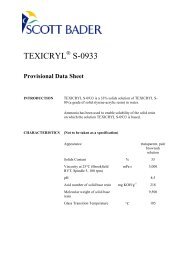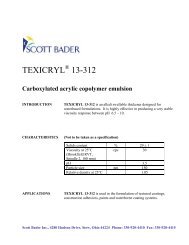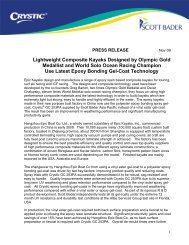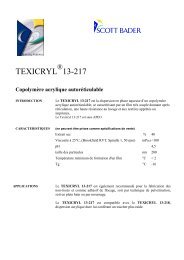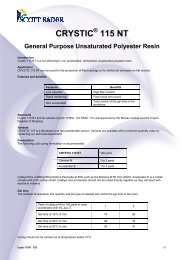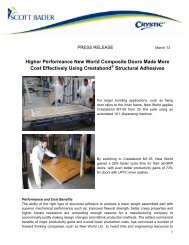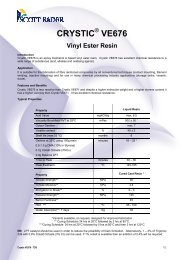Crystic 406 PA Resin - Scott Bader
Crystic 406 PA Resin - Scott Bader
Crystic 406 PA Resin - Scott Bader
You also want an ePaper? Increase the reach of your titles
YUMPU automatically turns print PDFs into web optimized ePapers that Google loves.
CRYSTIC ® <strong>406</strong><strong>PA</strong><br />
Low Styrene Emission and Low Exotherm<br />
Polyester <strong>Resin</strong><br />
Introduction<br />
<strong>Crystic</strong> <strong>406</strong><strong>PA</strong> is a pre-accelerated, thixotropic orthophthalic unsaturated polyester resin, with low styrene emission. Its<br />
rapid impregnation of glass fibre reinforcements, and low exotherm temperature, make it ideal for multi-layer laminates, in<br />
spray or hand lay applications.<br />
<strong>Crystic</strong> <strong>406</strong><strong>PA</strong> exhibits reduced exothermic heat on curing. This makes it suitable for the construction of thicker laminates<br />
where exothermic heat build up may distort the moulding or cause excessive shrinkage.<br />
Applications<br />
<strong>Crystic</strong> <strong>406</strong><strong>PA</strong> is recommended for the manufacture of boat hulls, vehicle bodies and industrial mouldings.<br />
Approvals<br />
<strong>Crystic</strong> <strong>406</strong><strong>PA</strong> is approved by Lloyd’s Register of Shipping for use in the construction of craft under their survey.<br />
Formulation<br />
<strong>Crystic</strong> <strong>406</strong><strong>PA</strong> should be allowed to attain workshop temperature (18ºC - 20ºC) before use. Stir well by hand, or with a<br />
low shear mixer to avoid aeration, and then allow to stand to regain thixotropy. <strong>Crystic</strong> <strong>406</strong><strong>PA</strong> requires only the addition<br />
of a catalyst to start the curing reaction. The recommended catalyst for normal conditions is Andonox ® KP9. Catalyst<br />
Norox ® MEKP-925H will increase the pot life under hot conditions. The catalyst should be thoroughly incorporated into<br />
the resin, with a low shear mechanical stirrer where possible.<br />
<strong>Crystic</strong> <strong>406</strong><strong>PA</strong> is formulated for room temperature curing applications. It requires only addition of the correct amount of<br />
catalyst to start the curing reaction. The recommended formulations are given in Table 1:<br />
Table1: Recommended formulations for room temperature curing of <strong>Crystic</strong> <strong>406</strong><strong>PA</strong>.<br />
Component<br />
Parts by weight<br />
<strong>Crystic</strong> <strong>406</strong><strong>PA</strong> 100<br />
Andonox ® KP9 or Norox ® MEKP-925H 1 to 3<br />
Pot Life<br />
The ambient temperature and the amount of Andonox ® KP9 or Norox ® MEKP-925H control the gel time of the<br />
formulation. This can be approximately determined from Table 2, which shows the gel times of various formulations<br />
of <strong>Crystic</strong> <strong>406</strong><strong>PA</strong>.<br />
Table 2: Geltimes in minutes for <strong>Crystic</strong> <strong>406</strong><strong>PA</strong><br />
= combination not recommended.<br />
Catalyst type Andonox ® KP9 Norox ® MEKP-925H<br />
Catalyst addition<br />
2.5% 2.0% 1.5% 1.0% 2.0% 1.5% 1.0%<br />
Temperature<br />
35°C 8.5 7 9 15<br />
25°C 10 13 18.5<br />
15°C 13 16 22<br />
<strong>Crystic</strong> <strong>406</strong><strong>PA</strong>- TDS 1/3
Curing should not be carried out at temperatures below 15°C. <strong>Scott</strong> <strong>Bader</strong> (Pty) Ltd. will not be liable for problems<br />
caused by use at lower temperatures than recommended. The resin must be allowed to attain workshop temperature<br />
before being formulated for use. 20°C is recommended.<br />
N.B. Peroxide catalysts are highly reactive and may decompose with explosive violence, or cause<br />
fires, if they come into contact with flammable materials, metals or accelerators. For this reason<br />
they must never be stored in metal containers or be mixed directly with accelerators.<br />
Additives<br />
The addition of certain pigments, fillers or extra styrene may adversely affect the properties of <strong>Crystic</strong> <strong>406</strong><strong>PA</strong>. Users<br />
should seek advice from our Technical Service Department before making any additions.<br />
Post Curing<br />
Satisfactory laminates for many applications can be made from <strong>Crystic</strong> <strong>406</strong><strong>PA</strong> by curing at workshop temperature (20ºC).<br />
For optimum properties and long term performance, however, laminates should be post cured before being put into<br />
service. The laminate should be allowed to cure for 24 hours at 20ºC, and then be oven cured for 3 hours at 80ºC or 16<br />
hours at 40ºC.<br />
Typical Properties<br />
The following tables give typical properties of <strong>Crystic</strong> <strong>406</strong><strong>PA</strong> when tested in accordance with BS 2782.<br />
Table 3: Typical properties of liquid and fully cured <strong>Crystic</strong> <strong>406</strong><strong>PA</strong><br />
Property Units Liquid <strong>Resin</strong><br />
Appearance<br />
Pinkish mauve<br />
Viscosity at 25ºC Brookfield RVT at 100rpm centipoise 650<br />
Thixotropic Index Ratio 2.0<br />
Specific Gravity at 25ºC 1.10<br />
Volatile Content % 36<br />
Acid Value mg KOH/g 18.5<br />
Stability at 20ºC months 3<br />
Geltime at 25ºC using 1% Andonox ® KP9 catalyst minutes 18.5<br />
Property<br />
Units<br />
Fully cured* resin<br />
(unfilled casting)<br />
Barcol Hardness (Model GYZJ 934-1) 45<br />
Deflection Temperature under load † (1.80 MPa) ºC 62<br />
Water Absorption 24 hours at 23ºC mg 14<br />
Tensile Strength Mpa 54<br />
Tensile Modulus Mpa 3700<br />
Elongation at Break % 1.7<br />
Specific Gravity at 25ºC 1.20<br />
Volumetric Shrinkage % 8.35<br />
* Curing Schedule - 24 hrs at 20ºC, 3 hrs at 80ºC<br />
† Curing Schedule - 24 hrs at 20ºC, 5 hrs at 80ºC, 3 hrs at 120ºC<br />
<strong>Crystic</strong> <strong>406</strong><strong>PA</strong> - TDS 2/3
Table 4: Typical interfacial properties of a <strong>Crystic</strong> <strong>406</strong><strong>PA</strong> chopped strand mat laminate<br />
Property Units Test Method Normal * <strong>Resin</strong>-rich**<br />
Unnotched Charpy impact strength<br />
kJ/m²<br />
ISO 179 72 70<br />
Single lap shear strength MPa BS 4994<br />
Appendix C<br />
3.8 3.9<br />
Short beam shear strength MPa BS 2782<br />
Method 341A<br />
22 (18.6†) 21 (19.4†)<br />
Fracture surface energy J/m² <strong>Scott</strong> <strong>Bader</strong><br />
Test<br />
350 300<br />
* 24hrs delay between 2 lay-ups of 2 x 450 g/m² chopped strand mat<br />
** 2 x 450 g/m² CSM. Allowed to gel. Then 700 g/m² pure resin interface. Then 24hrs delay. Then 2 x 450 g/m² CSM.<br />
† Data obtained using 5 days delay instead of 24hrs<br />
Storage<br />
<strong>Crystic</strong> <strong>406</strong><strong>PA</strong> should be stored in the dark in suitable closed containers. It is recommended that the storage<br />
temperature should be less than 20ºC where practical, but should not exceed 30ºC. Ideally, containers should be<br />
opened only immediately prior to use. Where they have to be stored outside, it is recommended that drums be kept in a<br />
horizontal position to avoid the possible ingress of water.<br />
Packaging<br />
<strong>Crystic</strong> <strong>406</strong><strong>PA</strong> is supplied in 25kg kegs, 225kg drums, and 1125kg intermediate bulk containers. Bulk supplies can be<br />
delivered by road tanker.<br />
Health and Safety<br />
Please see the applicable Material Safety Data Sheets, depending on the curing system used.<br />
Technical Leaflet No. 174.18SA<br />
Version 2 : February 2013<br />
All information on this data sheet is based on laboratory testing and is not intended for design purposes. <strong>Scott</strong> <strong>Bader</strong> makes no representations or warranties of any<br />
kind concerning this data. Due to variance of storage, handling and application of these materials, <strong>Scott</strong> <strong>Bader</strong> cannot accept liability for results obtained. The<br />
manufacture of materials is the subject of granted patents and patent applications; freedom to operate patented processes is not implied by this publication.<br />
SCOTT BADER COM<strong>PA</strong>NY LIMITED<br />
Wollaston, Wellingborough, Northamptonshire, NN29 7RL<br />
Telephone: +44 (0) 1933 663100<br />
Facsimile: +44 (0) 1933 666623<br />
www.scottbader.com<br />
<strong>Crystic</strong> <strong>406</strong><strong>PA</strong> - TDS 3/3





